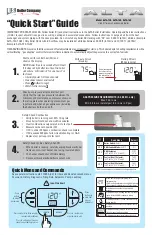
5
xtra
-
Installation & Servicing
GENERAL
FLUE SYSTEM DESIGN
Due to the high efficiency of these boilers, the flue gas
temperatures are low and the buoyancy in the stack will be
relatively small. The boiler is supplied with an integral fan which
is fully matched to the boiler in each case to provide correct
combustion air flow and overcome the flue resistance.
The power of this fan is such that there is a large reserve of
pressure available to overcome a significant length of flue
without affecting the combustion performance of the boiler. The
maximum pressure available at the base of the flue to overcome
flue resistance is 100Pa (0.4" w.g.) for F80 and F120, and 150Pa
(0.6" w.g.) for F160, F200, F240 and F280. This includes the
resistance of any air ducts used to connect the air inlet direct to
outside air. Care should be taken with tall flue systems to
ensure excess buoyancy is not created. A negative pressure
must not be created at the boiler flue outlet.
See table below for approximate maximum straight flue lengths.
Boiler
F80
F120
F160
F200
F240
F280
Flue Size (mm) Ø150
Ø150
Ø150
Ø200
Ø200
Ø200
Approx. max.
Straight Flue
240
109
100
256
180
138
Length (m)
If the high level air inlet kit, supplied with this appliance, is to be
utilised, the following table shows approximate maximum
straight flue lengths and pressures available.
Boiler
F80
F120
F160
F200
F240
F280
Flue Size (mm) Ø150
Ø150
Ø150
Ø200
Ø200
Ø200
Approx. max.
Straight Flue
235
105
50
136
72
46
Length (m)
Flue Pressure
98
97
76
80
60
50
(Pa)
The addition of elbows and their positions in the flue will have a
significant effect on the maximum flue length. Consult with your
flue supplier for detailed design work.
.
IMPORTANT NOTE.
If combustion air is drawn from within the boiler room, ensure
no dust or airborne debris can be ingested into the appliance.
Dusty concrete flooring should be sealed to reduce the
presence of dust. Ideally where possible duct the air supply
into the boiler room from a clean source outside the boiler
room/building.
Material
With no requirement for buoyancy to discharge flue products and
with low flue gas temperatures, single wall flues are suitable for
most installations. Care should still be taken to maintain
compliance with building regulations and relevant standards.
The type of flue pipe used should be aluminium, 316 grade
Stainless Steel or be of equivalent corrosion resistance
unless
the flue is manufactured from aluminium, the condensate
from the flue must be collected and drained before entering
the sump of the boiler
. Advice regarding the availability of
proprietary types of flue system can be obtained by contacting
Ideal Stelrad Group
. All joints or connections in the flue system
must be impervious to condensate leakage. Low points in the
flue system should be drained using pipe of material resistant
to condensate corrosion. All drains in the flue should
incorporate a water trap.
Care should also be taken in the selection of flue terminals as
these tend to accentuate the formation of a plume and could
freeze in cold weather conditions.
Care should be taken to ensure the specification of the chimney
is suitable for the application by reference to the manufacturers
literature.
WATER CIRCULATION SYSTEM
A circulation pump MUST be connected to the boiler, see below.
The boiler must NOT be used for direct hot water supply. The hot
water storage cylinder MUST be of the indirect type.
Single feed, indirect cylinders are not recommended and MUST
NOT be used on sealed systems.
The appliances are NOT suitable for gravity central heating nor
are they suitable for the provision of gravity domestic hot water.
The hot water cylinder and ancillary pipework, not forming part of
the useful heating surface, should be lagged to prevent heat loss
and any possible freezing - particularly where pipes run through
roof spaces and ventilated underfloor spaces.
The boiler must be vented. There must be no low points
between the boiler flow connection and a system vent point,
which should be positioned as close as practically possible to
the boiler flow connection.
Draining taps MUST be located in accessible positions, which
permit the draining of the whole system - including the boiler and
hot water storage vessel. They should be at least 1/2" BSP
nominal size and be in accordance with BS. 2879. Do not use
the boiler drain tap to drain the system as this can induce sludge
into the heat exchanger.
The central heating system should be in accordance with the
relevant standards listed on page 4.
Due to the compact nature of the boiler the heat stored within the
castings at the point of shutdown of the burner must be
dissipated into the water circuit in order to avoid overheating. In
order to allow pump operation after burner shutdown the boiler
control box incorporates a 5 minute pump overrun facility. In
order to make use of this, a pump must be supplied from the
terminals inside the boiler. Note: for pumps requiring greater
than 1.0 amp current, they must be connected via a relay.
When sizing pumps, reference should be made to the Hydraulic
Resistance Table on page 6 which show the boiler resistance
against flow rates, to achieve the required temperature
differential.
Flow rates for common systems using either 11
o
C or 20
o
C
temperature differentials are given in the table below.
Water flow rate temp.
Water flow rate temp.
difference 11
o
C (20
o
F)
difference 20
o
C (36
o
F)
l/s
m
3
/h
l/s
m
3
/h
F80
1.78
6.41
0.98
3.53
F120
2.68
9.65
1.47
5.3
F160
3.57
12.85
1.96
7.06
F200
4.51
16.24
2.48
8.93
F240
5.42
19.51
2.98
10.73
F280
6.32
22.75
3.47
12.49
Содержание F80
Страница 47: ...47 xtra Installation Servicing NOTES...






































